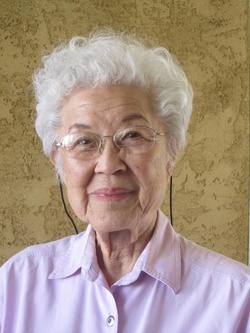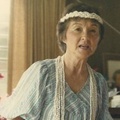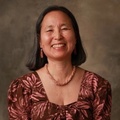Aiko Herzig-Yoshinaga is still a ball of fire at 89 years old. She was born in Sacramento, California, a Nisei (second generation Japanese). Her parents, Sanji Yoshinaga (father) and Shigeru, were from Kumamoto Prefecture on the island of Kyushu, Japan.
Her family moved to Los Angeles in 1933 and lived there until the spring of 1942 when they were taken by the U.S. government to concentration and internment camps. Aiko was 18 years old. She remembers her high school principal telling the Nisei in her senior class that they, “don”t deserve to receive our diplomas because YOUR people bombed Pearl Harbor.”
Aiko was a good friend of my father’s during high school in Los Angeles and remained friends until he died five years ago. Aiko has three children, 6 grandchildren, and a great-grandchild. Her husband Jack Herzig, now deceased, was dedicated to working with her to uncover the truth behind Executive Order 9066. She is an inspiration to me.
* * * * *
June Tanoue: What was your camp experience like?
Aiko Herzig-Yoshinaga: I would not recommend it for anyone, particularly for those who cherish freedom and privacy which we take for granted. Since I was at the end of my teen years when all of this occurred, I was very apolitical and did not comprehend the legal aspects of the deprivation of our constitutional rights.
My father died in the Rohwer concentration camp hospital at age 69. Medical care was very limited. My mother was recovering from a nervous breakdown which overcame her when war broke out in December of 1941, and father’s death slowed her recovery to a great degree. Having my first-born child in the Manzanar hospital was very different from what I experienced when I had two other children in a mainstream hospital in the 1950s, long after WWII had ended. Going through labor pains with several other women in the same ward was an experience that I have tried to erase from my memory.
Standing in line for each of three meals a day regardless of inclement weather was a great hardship, particularly for the aged. During the first months of incarceration, the meals were not nutritionally balanced, which negatively affected especially those inmates who required special diets for medical reasons. Eventually, meals served improved for the general population due to the produce cultivated and harvested by the Nikkei (Japanese descendants not citizens of Japan) farmers themselves.
One of the most distressing living conditions was the lack of privacy, whether it was in the barracks’ living quarters, called apartments, or in the latrines and showers. Since there was no running water in the living quarters, separate men and women’s toilets and bathing facilities (showers) were built. In order to use those facilities, it was necessary to leave our apartments even in the dead of night. For people afflicted with infirmities, this was a great inconvenience. In some camps many months passed before partitions were constructed to separate toilets and showering areas to allow some measure of privacy for individuals.
In Manzanar, the first camp in which my husband and I were imprisoned, the six-beam apartment assigned to us was 20 feet by 25 feet and in this cramped quarters there were three separate families—six adults and one child. When we entered this room, the only furniture was a coal-burning heater and blankets on iron bed cots with a large sack which we were told needed to be filled with straw and would serve as our mattress.
The one fixture in each apartment was a single hanging light bulb. A thin wallboard dividing one apartment from the next one did not reach the roof so that conversations in one room would carry into other quarters in the same barrack. The tarpapered barracks did not afford much protection against either the boiling heat of summertime or the frigid cold of winter days.
Of the many denial of constitutional rights endured by the Nikkei was the conscription of our men folks from the concentration camps to serve in the U.S. Army. This egregious policy on the part of the government is a long tale in itself and speaks loudly to the injustice of the entire exclusion and imprisonment program.
JT: What work did you and Jack do and why did you do it?
AHY: I was the Senior Research Associate for the Commission on Wartime Relocation & Internment of Civilians (CWRIC) . At his retirement Jack joined me in the research work at the National Archives & Records Center (NARA). We conducted research at the presidential library of Franklin D. Roosevelt in Hyde Park, NY, branches of NARA (such as the one in San Bruno, CA), the Gen. George Marshall Library in Kentucky, and various other resources to seek archival information as we studied the wartime tragedy that befell the West Coast Nikkei.
My initial motivation to begin researching the subject began before my association with the CWRIC. Since our residence in Virginia was just a 20-25 minute drive to the NARA, I sought and found my records and those of my family members. There were various questionnaires that we were required to fill out, medical records, school records, there were records of transfers from camp to camp and the infamous “loyalty questionnaire.”*
My friend, Michi N. Weglyn, author of the seminal publication, Years of Infamy: The Untold Story of America’s Concentration Camps, pressed me to look into the records of the government agencies that were associated with the concentration camps—the genesis of the sad episode of eviction/incarceration of the Nikkei.
That is how I began to understand the history of our wartime experience. It was not my initial goal to do that type of research but I came to know the location of records in NARA of certain aspects of the exclusion order, followed by our imprisonment.
The material that we collected formed the basis for CWRIC’s final report to the President (Reagan) and the Congress. After years of debate in Congress, the Civil Liberties Act of 1988 (the so-called “Redress Bill”) was passed and survivors of the concentration and internment camps received a token compensation of $20,000 for deprivation of civil rights.
Jack and I were also involved in searching for evidentiary documentation for the three coram nobis cases—Hirabayashi, Korematsu, and Yasui—as well as for the class action lawsuit of the National Council for Japanese American Redress (referred to as Hohri et al vs. USA), so we continued to go to NARA for years after the CWRIC closed its doors in 1983. We also responded to requests from Nikkei who wished to find camp records about themselves or their families, or in answer to scholars who sought information for their writings or their classes.
JT: What do you think or hope your legacy will be?
AHY: Copies of most of the historical government documents that Jack and I had collected have been donated to UCLA Asian American Studies Center. They will eventually be available for researchers through UCLA’s Special Collection Library.
None of us are infallible—including government officials and politicians whom I had admired as icons to be emulated—and acceptance of this fact became so clear as I did the research. It is my fervent hope that persons who review the historical documents that we gathered will help to develop more respect for the individuality and dignity of others, regardless of ethnicity, gender, and religious beliefs.
*This article was originally published in the Halau i Ka Pono Hula Newsletter in September 2013.
© 2014 June Yoshiko Tanoue





